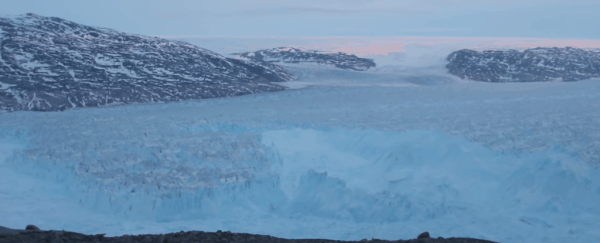Want to see something really amazing? Well, you can enjoy this video of an iceberg breaking off Helheim Glacier in eastern Greenland.
Filmed by scientists on June 22, it shows an absolutely huge 6.4-kilometre (4-mile) chunk of ice making a break for the sea.
Iceberg calving, as it is known, is not unusual. It's a natural consequence of the expansion of ice into the sea, and it's estimated that Greenland's glaciers produce somewhere between 15,000 and 30,000 icebergs per year.
And calving can be an incredible event to witness. As the ice breaks away from the glacier, it creates an enormous cracking or booming sound, and it sends tremendous waves rippling through the ocean.
They're not usually this hefty, though. Icebergs are usually classified as chunks greater than 5 metres (16 feet) across, and anything over 122 metres (400 feet) is considered large for an iceberg.
But, while the process may be a natural one, Helheim's calving is still a cause for worry. This is because Greenland's "big three" glaciers, Helheim, Jakobshavn/Ilulissat and Kangerdlussuaq, have sped up in recent years - an acceleration scientists argue is caused by climate change.
Why is this a problem? Because icebergs falling off into the sea aren't just a hazard for ships - they also one of the factors contributing to increasing the volume of the world's oceans, raising sea levels.
As we have previously reported, global sea levels are creeping up by about 3 millimetres per year at the moment, but that figure is not steady - every 12 months it grows by another 0.08 millimetres, and researchers know that the melting of Greenland is a particularly strong contributor to this awful trend.
And all that extra mass is pushing the seafloor down, too.
"Global sea-level rise is both undeniable and consequential," said atmosphere ocean scientist David Holland of New York University. "By capturing how it unfolds, we can see, first-hand, its breathtaking significance."
The video shows the calving over around 30 minutes, filmed at 11:30 pm local time (the Sun sets very late in Summer in Greenland), sped up to around 90 seconds so you can see the whole thing.
Unfortunately this means we miss out on the amazing sounds, but we can see the icy ocean come rushing into the rift as the iceberg moves away.
As impressive as it is, it's not the biggest iceberg ever recorded. That honour goes to an iceberg called B-15, which broke off Antarctica in March 2000, measuring a whopping 11,000 square km (4,247 square miles).
But it's still sobering. According to a 2017 estimate, if the entire West Antarctic Ice Sheet were to melt, it would raise global sea levels by 3.2 metres (10 feet).
"Knowing how and in what ways icebergs calve is important for simulations because they ultimately determine global sea-level rise," said logistics coordinator Denise Holland of NYU.
"The better we understand what's going on means we can create more accurate simulations to help predict and plan for climate change."
